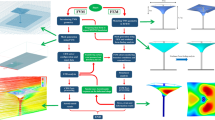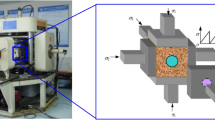Abstract
The ConVergence-ConFinement (CV-CF) method is widely used in conventional tunneling at a preliminary stage of the design. In this method, the rock–support interaction is simplified by means of a two-dimensional plane-strain assumption. However, when the ground exhibits large deformation and/or when the support is very stiff and installed close to the tunnel face, the results obtained with the CV-CF method may significantly differ from those obtained using 3D numerical computations. The strong interaction taking place between the rigid lining and the rock mass is not considered in the most common use of the CV-CF method. Some improvements of the CV-CF method as the so-called implicit methods have been developed to better account for this interaction. In this paper, the applicability of the CV-CF methods is discussed for full-face excavation tunneling with a stiff support system. An in-depth comparison between plane-strain closed form solutions and numerical results which properly accounts for the 3D effects at the vicinity of the tunnel face is carried out. The range of application of the different approaches of the CV-CF method is discussed. Finally, some simple empirical formulae which can be used in preliminary design for a large range of ground conditions are proposed.











Similar content being viewed by others
Abbreviations
- \(x\) :
-
Distance to the tunnel face
- \(R\) :
-
Tunnel radius
- \(D\) :
-
Tunnel diameter
- \(d\) :
-
Distance of support/lining installation from the tunnel face
- \({x_{\text{f}}}\) :
-
Distance between the edge of the lining and the tunnel face (unsupported length)
- \(s\) :
-
Step round length in the numerical simulations
- \(e\) :
-
Thickness of the support or the lining
- \({R}_{o}\) :
-
Outer radius of a lining
- \({R_{\text{i}}}\) :
-
Inner radius of a lining
- \(\lambda \left(x\right)\) :
-
Deconfining rate which depends on the distance to the advancing face x
- \(c\) :
-
Cohesion of the ground
- ϕ:
-
Friction angle of the ground
- \(\psi\) :
-
Dilatancy angle of the ground
- \({K_{\text{p}}}\) :
-
Friction parameter of the ground
- \(\beta\) :
-
Dilatancy parameter of the ground
- \(\upsilon\) :
-
Poisson’s ratio of the ground
- \(E\) :
-
Young’s modulus of the ground
- \(G\) :
-
Shear modulus of the ground
- \({\upsilon _{\text{l}}}\) :
-
Poisson’s ratio of the support or the lining
- \({E_{\text{l}}}\) :
-
Young’s modulus of the support or the lining
- \({G_{\text{l}}}\) :
-
Shear modulus of the support or the lining
- \(N\) :
-
Stability number
- \({R_{{\text{pl}}}}\) :
-
Plastic radius (unsupported opening)
- \({k_{{\text{sn}}}}\) :
-
Normal stiffness of the support
- \({K_{{\text{sn}}}}\) :
-
Normal stiffness of a lining
- \(u\left( x \right)\) :
-
Radial displacement at the tunnel wall which depends on the distance to the advancing face \(x\) (unsupported opening)
- \(\bar {u}\left( x \right)\) :
-
Radial displacement at the tunnel wall which depends on the distance to the advancing face \(x\) (supported opening)
- \({p_{\text{f}}}\) :
-
Fictitious pressure applied to the tunnel boundary (to account for the influence of the tunnel face)
- \({\sigma _0}\) :
-
Initial isotropic stress state in the ground
- \({\sigma _{\text{c}}}\) :
-
Uniaxial compression strength
- \({p_{\text{s}}}\) :
-
Radial pressure acting upon the outer boundary of the lining
- \({\sigma _{\text{max}}}\) :
-
Maximal hoop stress developed in the support or the lining at the state of equilibrium
- \(\chi\) :
-
Homothetic ratio in the Self Similarity Principle
- \(\ldots {,^*}\) :
-
Normalized parameter/variable
- \(\ldots ,{~_{{\text{el}}}}\) :
-
Elastic parameter/variable
- \(\ldots ,{~_{{\text{pl}}}}\) :
-
Elastoplastic parameter/variable
References
AFTES (2002) Recommandations pour l’emploi de la méthode convergence-confinement. Tunnels et Ouvrages Souterrains 170:79–89 (in French)
Barla G (2016) Full-face excavation of large tunnels in difficult conditions. J Rock Mech Geotech Eng 8(3):294–303
Bernaud D, Rousset G (1992) La « nouvelle méthode implicite » pour l’étude du dimensionnement des tunnels. Revue française de Géotechnique 60:5–26 (in French)
Bernaud D, Benamar I, Rousset G (1994) La « nouvelle méthode implicite » pour le calcul des tunnels dans les milieux élastoplastiques et viscoplastiques. Revue française de Géotechnique 68:3–19 (in French)
Cantieni L, Anagnostou G (2009) The effect of the stress path on squeezing behavior in tunneling. Rock Mech Rock Eng 42(2):289–318
Corbetta F, Bernaud D, Nguyen-Minh D (1991) Contribution à la méthode convergence-confinement par le principe de la similitude. Revue française de géotechnique 54:5–11 (in French)
De Labriolle GC (2017) Amélioration des méthodes analytiques basées sur des concepts, simples pour le dimensionnement des tunnels superficiels et profonds en sol meuble. Revue Française de Géotechnique 151:2 (in French)
De la Fuente M, Taherzadeh R, Sulem J, Nguyen XS, Subrin D (2018a) Maximal hoop stress developed in the lining of a tunnel excavated with a single shield TBM at the state of equilibrium (comparison between different calculation methods). Rock Mech Rock Eng. https://doi.org/10.5281/zenodo.1475967
De la Fuente M, Taherzadeh R, Sulem J, Nguyen XS, Subrin D (2018b) Radial displacement at the tunnel wall of a tunnel excavated with a single shield TBM at the state of equilibrium (comparison between different calculation methods). Rock Mech Rock Eng. https://doi.org/10.5281/zenodo.1476007
Eisenstein Z, Branco P (1991) Convergence-confinement method in shallow tunnels. Tunn Undergr Space Technol 6(3):343–346
Flügge W (1960) Stresses in shells. Springer, Berlin, Heidelberg
Gonzalez-Nicieza C, Alvarez-Vigil AE, Menendez-Diaz A, Gonzalez-Palacio C (2008) Influence of the depth and shape of a tunnel in the application of the convergence–confinement method. Tunn Undergr Space Technol 21(1):25–37
Itasca (2005) FLAC3D Numerical Software Package. Itasca Consulting Group Inc, Lagrangian Analysis of Continua
Lee SW, Jung JW, Nam SW, Lee IM (2007) The influence of seepage forces on ground reaction curve of circular opening. Tunn Undergr Space Technol 22(1):28–38
Nguyen-Minh D, Guo C (1996) Recent progress in convergence-confinement method. In: Barla (ed) Eurock’96, Turin, pp 855–860
Oreste P (2009) The convergence-confinement method: roles and limits in modern geomechanical tunnel design. Am J Appl Sci 6(4):757–771
Panet M (1995) Le calcul des tunnels par la méthode convergence-confinement. Presses de l’Ecole Nationale des ponts et chaussées, Paris (in French)
Panet M, Guellec P (1974) Contribution à l’étude du soutènement d’un tunnel à l’arrière du front de taille. Progrès en mécanique des roches comptes rendus du 3eme congrès de la société internationale de mécanique des roches, Denver (2) (in French)
Panet M, Guenot A (1983) Analysis of convergence behind the face of a tunnel: tunnelling 82. In: Proceeding of the 3rd international symposium, Brighton, pp 197–204
Ramoni M, Lavdas N, Anagnostou G (2011) Squeezing loading of segmental linings and the effect of backfilling. Tunn Undergr Space Technol 26(6):692–717
Schürch R, Anagnostou G (2012) The applicability of the ground response curve to tunnelling problems that violate rotational symmetry. Rock Mech Rock Eng 45(1):1–10
Sulem J, Panet M, Guenot A (1987) An analytical solution for time-dependent displacements in a circular tunnel. Int J Rock Mech Min Sci Geomech Abstr 24(3):155–164
Tran-Manh H, Sulem J, Subrin D (2015) A closed-form solution for tunnels with arbitrary cross section excavated in elastic anisotropic ground. Rock Mech Rock Eng 48(1):277–288
Vlachopoulos N, Diederichs MS (2009) Improved longitudinal displacement profiles for convergence confinement analysis of deep tunnels. Rock Mech Rock Eng 42(2):131–146
Vlachopoulos N, Diederichs MS (2014) Appropriate uses and practical limitations of 2D numerical analysis of tunnels and tunnel support response. Geotech Geol Eng 32(2):469–488
Wong H, Subrin D, Dias D (2006) Convergence confinement analysis of a bolt-supported tunnel using the homogenization method. Can Geotech J 43(5):462–483
Acknowledgements
This work is part of the Ph.D. thesis of the first author, carried out at Ecole des Ponts ParisTech in partnership with Tractebel ENGIE and CETU (Centre d’Études des Tunnels). The authors wish to thank ITASCA for supporting the first author through the Itasca Education Partnership Program (IEPP).
Author information
Authors and Affiliations
Corresponding author
Additional information
Publisher’s Note
Springer Nature remains neutral with regard to jurisdictional claims in published maps and institutional affiliations.
Electronic supplementary material
Below is the link to the electronic supplementary material.
Appendix: CV-CF Methods for Double-Shield TBM
Appendix: CV-CF Methods for Double-Shield TBM
In an attempt to assess the applicability of the CV-CF methods to tunnels excavated with a double-shield TBM, some numerical simulations have been carried out by fixing the value of the parameter \({d^{\text{*}}}\) to 2. The results are summarized in Figs. 12 and 13. It is inferred from the results that a classical CV-CF method in combination with the LDP of Panet provides an equilibrium state which is in agreement with the numerical simulations if \({E^*}\) > 0.25. The effect of the stiffness of the lining on the GRC is less than in the case of single-shield tunneling. The implicit method of Guo and Minh combined with an LDP of Panet provides also reasonable results except for N = 5 where the implicit method reaches its limits (N = 5 and \({d^{\text{*}}}\) = 2).
Rights and permissions
About this article
Cite this article
De La Fuente, M., Taherzadeh, R., Sulem, J. et al. Applicability of the Convergence-Confinement Method to Full-Face Excavation of Circular Tunnels with Stiff Support System. Rock Mech Rock Eng 52, 2361–2376 (2019). https://doi.org/10.1007/s00603-018-1694-8
Received:
Accepted:
Published:
Issue Date:
DOI: https://doi.org/10.1007/s00603-018-1694-8






